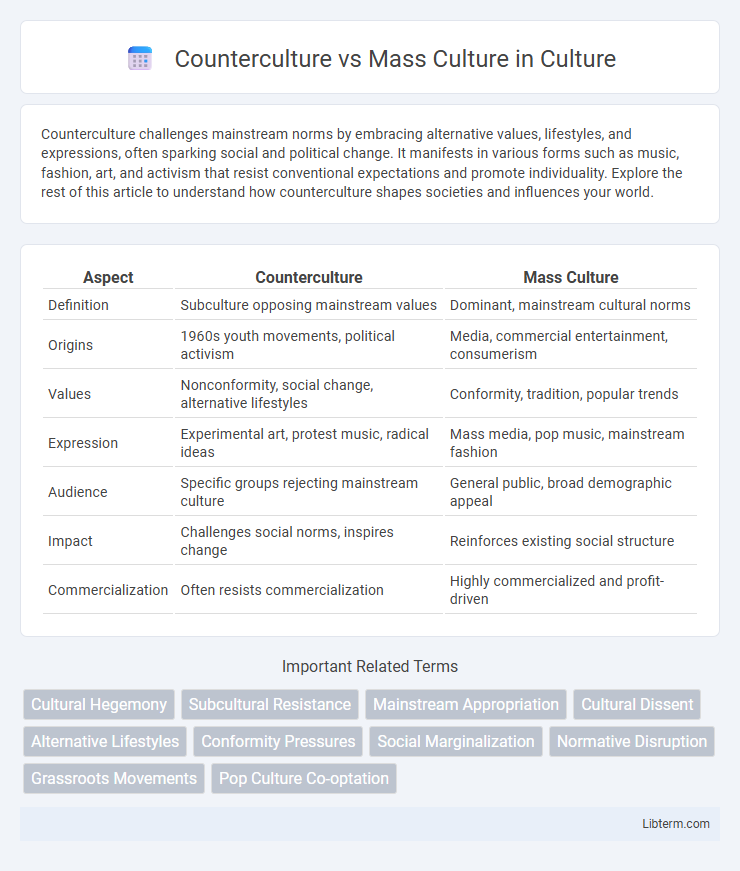Counterculture challenges mainstream norms by embracing alternative values, lifestyles, and expressions, often sparking social and political change. It manifests in various forms such as music, fashion, art, and activism that resist conventional expectations and promote individuality. Explore the rest of this article to understand how counterculture shapes societies and influences your world.
Table of Comparison
| Aspect | Counterculture | Mass Culture |
|---|---|---|
| Definition | Subculture opposing mainstream values | Dominant, mainstream cultural norms |
| Origins | 1960s youth movements, political activism | Media, commercial entertainment, consumerism |
| Values | Nonconformity, social change, alternative lifestyles | Conformity, tradition, popular trends |
| Expression | Experimental art, protest music, radical ideas | Mass media, pop music, mainstream fashion |
| Audience | Specific groups rejecting mainstream culture | General public, broad demographic appeal |
| Impact | Challenges social norms, inspires change | Reinforces existing social structure |
| Commercialization | Often resists commercialization | Highly commercialized and profit-driven |
Introduction to Counterculture and Mass Culture
Counterculture represents a social movement that actively challenges mainstream values, norms, and practices, often promoting alternative lifestyles and radical ideologies. Mass culture, in contrast, encompasses the shared cultural products, experiences, and media consumed widely by a majority, reflecting dominant societal norms and commercial interests. The tension between counterculture and mass culture highlights dynamics of conformity, resistance, and cultural hegemony within modern societies.
Defining the Concepts: Counterculture vs Mass Culture
Counterculture represents a social group that actively rejects and opposes mainstream norms and values, often promoting alternative lifestyles and radical ideas. Mass culture refers to widespread cultural elements, created for the general public, typically characterized by standardized entertainment, consumer products, and media that reflect dominant societal norms. The key distinction lies in counterculture's resistance to homogenization, while mass culture embraces and perpetuates mainstream preferences and commercial interests.
Historical Evolution of Counterculture
The historical evolution of counterculture can be traced back to the 1960s, when movements like the hippie era challenged mainstream values through alternative lifestyles, anti-war protests, and psychedelic art. This period marked a significant divergence from mass culture, which emphasized consumerism, conformity, and media-driven norms upheld by dominant societal institutions. Over time, counterculture influenced music, fashion, and political activism, becoming a catalyst for social change while resisting the homogenizing effects of mass-produced culture.
Origins and Growth of Mass Culture
Mass culture originated in the early 20th century with the rise of industrialization, urbanization, and mass media, which facilitated the widespread distribution of standardized cultural products. This growth was driven by technological advancements such as radio, cinema, and print media, enabling a broad audience to access shared entertainment, news, and consumer goods. The expansion of mass culture created a homogenized social experience, contrasting with the diverse and often oppositional nature of counterculture movements that emerged in response.
Key Characteristics of Counterculture
Counterculture exhibits key characteristics such as rejection of mainstream societal norms, pursuit of alternative lifestyles, and emphasis on individual freedom and self-expression. It often includes distinct values, beliefs, and symbols that challenge mass culture's dominant ideologies. Counterculture movements promote social change and creativity, fostering communities centered around shared dissent and innovation.
Core Features of Mass Culture
Mass culture is characterized by its widespread accessibility, standardized products, and commercial orientation designed to appeal to a broad audience. It emphasizes mass media distribution, often promoting conformity and consumerism while prioritizing entertainment and profit over individuality. These core features contrast sharply with counterculture, which typically challenges societal norms and resists mainstream commercialization.
Cultural Conflicts and Tensions
Counterculture challenges mass culture by rejecting mainstream values, creating cultural conflicts rooted in differing beliefs about identity, freedom, and social norms. These tensions fuel debates over artistic expression, political ideologies, and lifestyle choices, often highlighting generational divides. The clash between counterculture movements and dominant mass culture reshapes societal norms and influences cultural evolution.
Influences of Counterculture on Society
Counterculture movements have significantly reshaped societal norms by challenging mainstream values and promoting alternative lifestyles, art, and political activism. These influences led to greater social awareness, shifts in fashion, music, and language, as well as progressive reforms in civil rights and environmental policies. The legacy of counterculture is evident in contemporary culture's embrace of diversity, individualism, and resistance to conformity.
The Impact of Mass Culture on Everyday Life
Mass culture profoundly shapes everyday life by standardizing tastes, behaviors, and consumption patterns, leading to widespread homogenization of cultural experiences. The pervasive influence of mass media, advertising, and popular entertainment creates shared norms and values that often eclipse localized or individual expressions. This cultural standardization impacts identity formation, social interactions, and consumer habits, reinforcing dominant societal ideologies through accessible and repetitive cultural products.
Future Trends: Counterculture in a Mass-Mediated World
Counterculture movements increasingly leverage digital platforms to challenge mass culture norms, blending grassroots activism with global online communities. Emerging technologies such as virtual reality and decentralized social networks enable countercultures to maintain identity while reaching broader audiences. Future trends suggest a dynamic interplay where counterculture both resists and reshapes mass culture within mass-mediated ecosystems.
Counterculture Infographic

 libterm.com
libterm.com